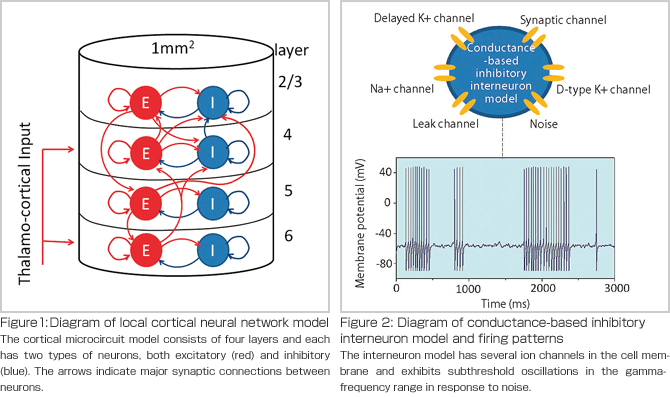
A Large-scale Simulation Model of Cortical
Microcircuits: CMDN
(Cortical Microcircuit Developed on NEST)

Brain and Neural System Team
Jun IGARASHI
The neocortex (part of the cerebral cortex), which covers a large area in the brains of mammals, is involved in higher functions such as sensory perception, voluntary movement, learning and cognition. Areas in the neocortex each respond to a specific sensory stimulus such as vision, hearing, smell and somatic sensation, with a majority of the areas consisting of six layers from the surface to the inner part of the brain. The characteristics of neurons are unique to each layer, while the synaptic connections between neurons in and outside of the layers are extremely complex, yet orderly. Although it is clear that the neurons in all neocortical layers work closely together to process information, the exact rules of processing remain unknown.
The key phenomena in understanding the mechanism of neocortical information processing are patterns of brain waves in specific frequency ranges, called gamma and theta waves. It is reported that, when an animal performs certain cognitive activities, brain waves within a specific frequency range, such as gamma waves, are generated in the neocortex, in addition to an increased correlation of brain waves between the linked neocortical areas. Brain waves are oscillatory phenomena in the local field potentials, believed to be caused mainly by the synaptic current generated when the synchronization of populations of neurons occurs. Consequently, this synchronization is likely to have some role in neocortical information processing, although the details are not yet understood. Understanding the neural mechanisms behind the synchronization in each cortical layer and its influence on interlayer correlation is essential in uncovering the information processing structure of cortical microcircuits. A simulation model should allow direct comparison to electrophysiological data as a means to navigate through the complexity of cortical microcircuits.
Building on the cortical microcircuit model developed by our co-researchers, T. Potjans and M. Diesmann, we are currently conducting simulation research with the aim of uncovering the role of the synchronization activities in the gamma-frequency range within the neocortical layer structure (Figure 1). The simulation model achieved a detailed recreation of synaptic connection patterns in neurons in each neocortical layer by applying a vast range of findings obtained from anatomical experiments. While a relatively-simple neuron model was previously employed in order to reduce the amount of calculation, the model that we currently use is a conductance-based inhibitory interneuron model as our research necessitates the recreation of neuron behaviors, especially in relation to the synchronization activities in the gamma-frequency range (Figure 2). The conductance-based model recreates more authentic electrophysiological characteristics of neurons by taking into account ion channels in the neuronal membrane. As it is reported that physiological experiments showed that certain types of inhibitory interneurons are linked to generation of subthreshold oscillations and the induction of synchronization activities in the gamma-frequency range, the ability to recreate the characteristics in detail is crucial in understanding the nature of such activities.
The cortical microcircuit model consists of approximately 80,000 neurons and five hundred million synaptic connections, making the amount of calculation for simulation far from small. Still, the size of the model translates into the equivalent of a mere 1mm2 of the brain surface, only a fraction of the size required for the simulation of the entire neocortex. Current computers, however, do not have sufficient calculation capacity to handle the largescale simulation model we would need next. To this end, our team is now working on the development of a large-scale simulation model for the cortical microcircuit using the next-generation super computer. The largescale simulation model will allow us to study the interactions that occur between neocortical columns.

BioSupercomputing Newsletter Vol.2
- SPECIAL INTERVIEW
- Aiming to Become a Global Trendsetter in the Life Sciences by Making the Best Use of the Next-generation Supercomputer!
Computational Science Research Program Deputy Program Director
Ryutaro HIMENO
- A Message from the Team Leader
- Simulating Cell Phenomena by Recreating Cells as They Exist in Living Organisms
Cell Scale Team Team Leader
Hideo YOKOTA - Create a Brain on a Supercomputer to Unravel the Functions of the Brain and Nervous System
Brain and Neural Systems Team Team Leader
Shin ISHII - High-performance Computing Environment to Maximize the Potential of the Next-generation Supercomputer
High-performance Computing Team Team Leader
Makoto TAIJI
- Report on Research
- Protein Reaction Simulation Based on All-electron Calculation
Institute of Industrial Science, the University of Tokyo
Fumitoshi SATO / Toshiyuki HIRANO / Noriko UEMURA / Naoki TSUNEKAWA / Junichi MATSUDA - Full Eulerian Fluid-structure Coupled Method
Associate Professor at School of Engineering, the University of Tokyo
Kazuyasu SUGIYAMA - A Large-scale Simulation Model of Cortical Microcircuits: CMDN(Cortical Microcircuit Developed on NEST)
Brain and Neural System Team
Jun IGARASHI - Development of Next-generation Molecular Dynamics Simulation Programs
High-performance Computing Team
Hiroshi KOYAMA / Yosuke OHNO / Gen MASUMOTO / Aki HASEGAWA / Gentaro MORIMOTO
